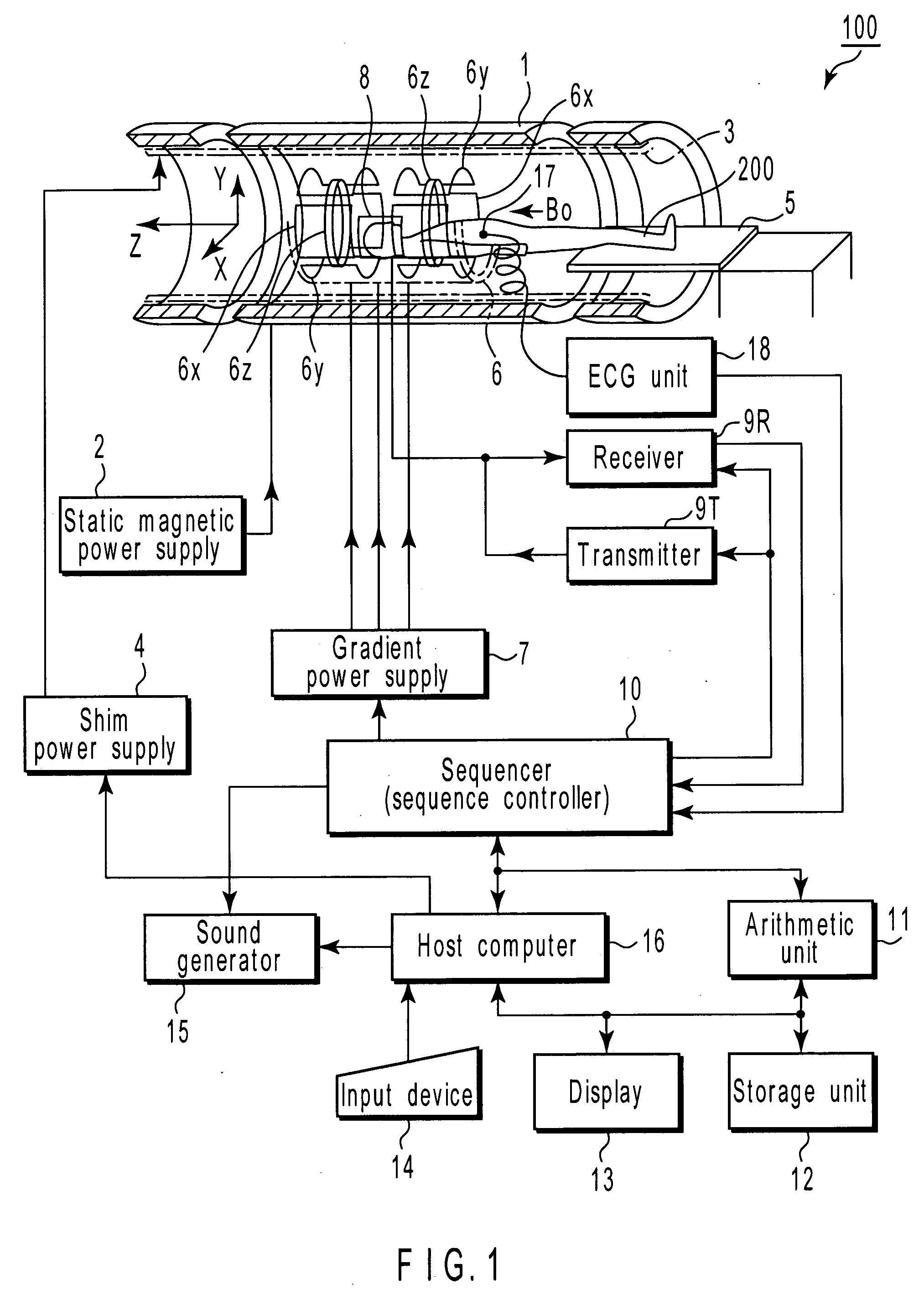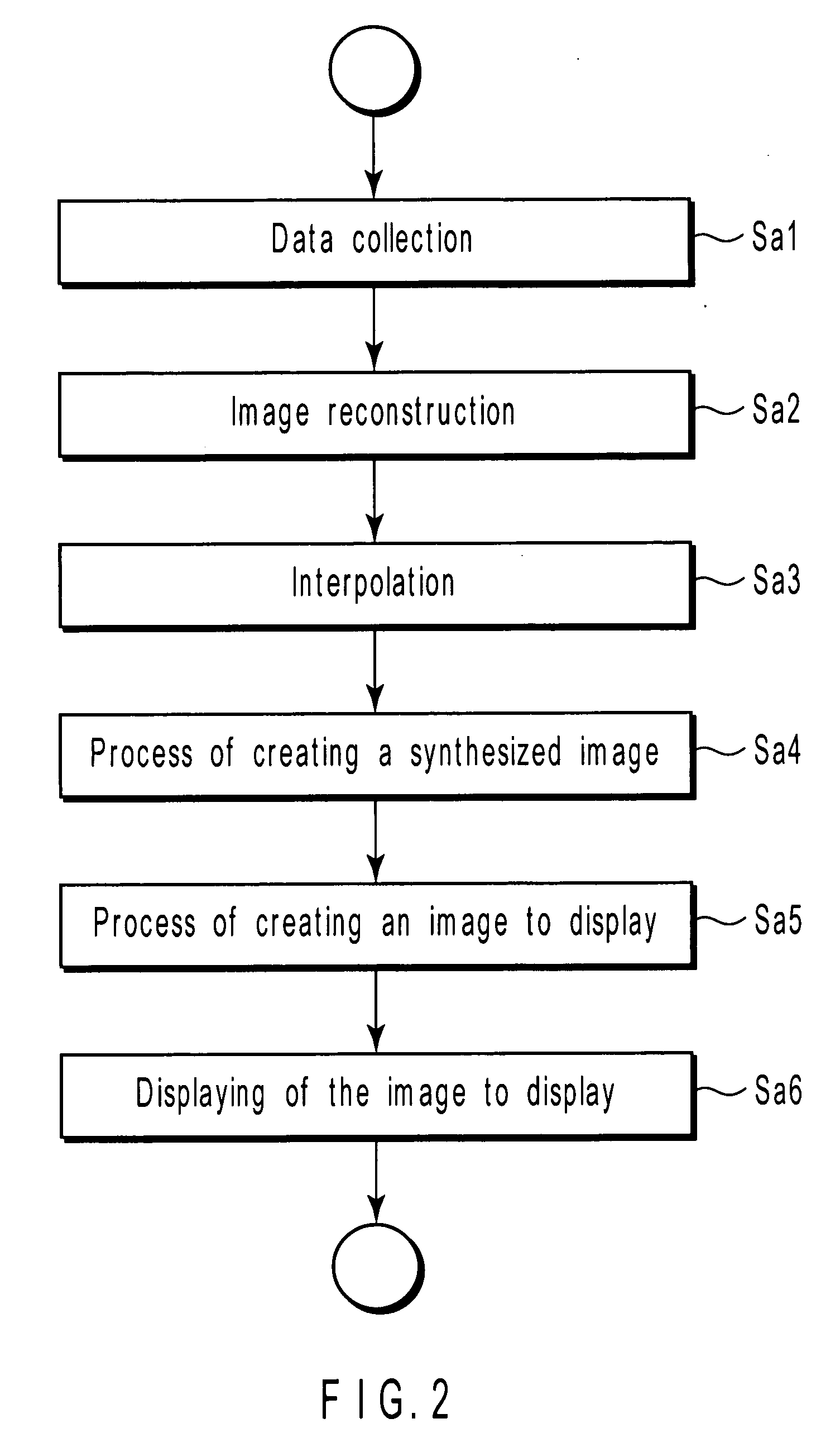Magnetic-resonance image diagnostic apparatus and method of controlling the same
a magnetic resonance image and diagnostic apparatus technology, applied in the field of magnetic resonance image diagnostic apparatus, can solve the problems of insufficient phase dispersion of blood flow, insufficient signal level, image not demonstrating arteries more clearly, etc., and achieves the effect of high precision
- Summary
- Abstract
- Description
- Claims
- Application Information
AI Technical Summary
Benefits of technology
Problems solved by technology
Method used
Image
Examples
first embodiment
[0073] The first embodiment will be described. The first embodiment is designed to achieve the first desire.
[0074]FIG. 2 is a flowchart explaining the sequence of processes the host computer 16 performs in the first embodiment to provide images.
[0075] In Step Sa1, the host computer 16 instructs the sequencer 10 to collect data. Upon receiving the instruction, the sequencer 10 collects data as will be explained below.
[0076]FIG. 3 is a diagram visualizing the pulse sequence in the first embodiment. FIG. 3 shows the waveform of a radio-frequency pulse (RF), the waveform of a gradient magnetic field (Gss), the waveform of another gradient magnetic field (Gpe), the waveform of a gradient magnetic field (Gro) and the waveform of an echo signal (Echo), in descending order. The pulse (RF) is applied to the object to be imaged. The wave (Gss) extends in the slice direction, the wave (Gpe) in the phase encode direction, and the wave (Gro) in the read-out direction.
[0077] As seen from FIG....
second embodiment
[0117] The second embodiment will be described. The second embodiment is designed to achieve the second desire.
[0118]FIG. 12 is a diagram visualizing the pulse sequence in the second embodiment. More precisely, this figure shows the waveform of a radio-frequency pulse (RF), the waveform of a gradient magnetic wave (Gss), the waveform of another gradient magnetic wave (Gpe), the waveform of a gradient magnetic wave (Gro) and the waveform of an echo signal (Echo), in descending order. The pulse (RF), gradient magnetic waves (Gss, Gpe and Gro) and echo signal (Echo) are applied to the object to be imaged. The wave (Gss) extends in the slice direction, the wave (Gpe) in the phase encode direction, and the wave (Gro) in the read-out direction.
[0119] As seen from FIG. 12, the pulse sequence used in the second embodiment accords with the gradient echo method. The second embodiment differs from the first embodiment in that rephasing is performed for the echo time as disclosed in the refer...
third embodiment
[0122] The imaging method used in the magnetic resonance imaging diagnostic apparatus 100 according to the first embodiment, i.e., the imaging method using a pulse sequence for the gradient echo system, which includes a dephase gradient-magnetic-field pulse, will be hereinafter referred to as flow-sensitive black blood (FSBB) imaging.
[0123] In the FSBB imaging, the phase of each flow such a blood flow, which is a motion, is gradually distributed, and the vector sum of the flow spins gradually decreases. That is, the amplitude component of the flow signal is gradually attenuated. As a result, the signal of the flow is suppressed and an image will be obtained, in which any blood vessel is represented by a low-level signal. Generally, a b-factor is used, which indicates a dephase amount. The b-factor is a tensor amount defined by equations (2) and (3) above.
[0124] In equation (3), γ is a gyromagnetic ratio of about 2π×42.6 MHz / T, and G(t) is a gradient-magnetic-field waveform vector....
PUM
 Login to View More
Login to View More Abstract
Description
Claims
Application Information
 Login to View More
Login to View More - R&D
- Intellectual Property
- Life Sciences
- Materials
- Tech Scout
- Unparalleled Data Quality
- Higher Quality Content
- 60% Fewer Hallucinations
Browse by: Latest US Patents, China's latest patents, Technical Efficacy Thesaurus, Application Domain, Technology Topic, Popular Technical Reports.
© 2025 PatSnap. All rights reserved.Legal|Privacy policy|Modern Slavery Act Transparency Statement|Sitemap|About US| Contact US: help@patsnap.com



